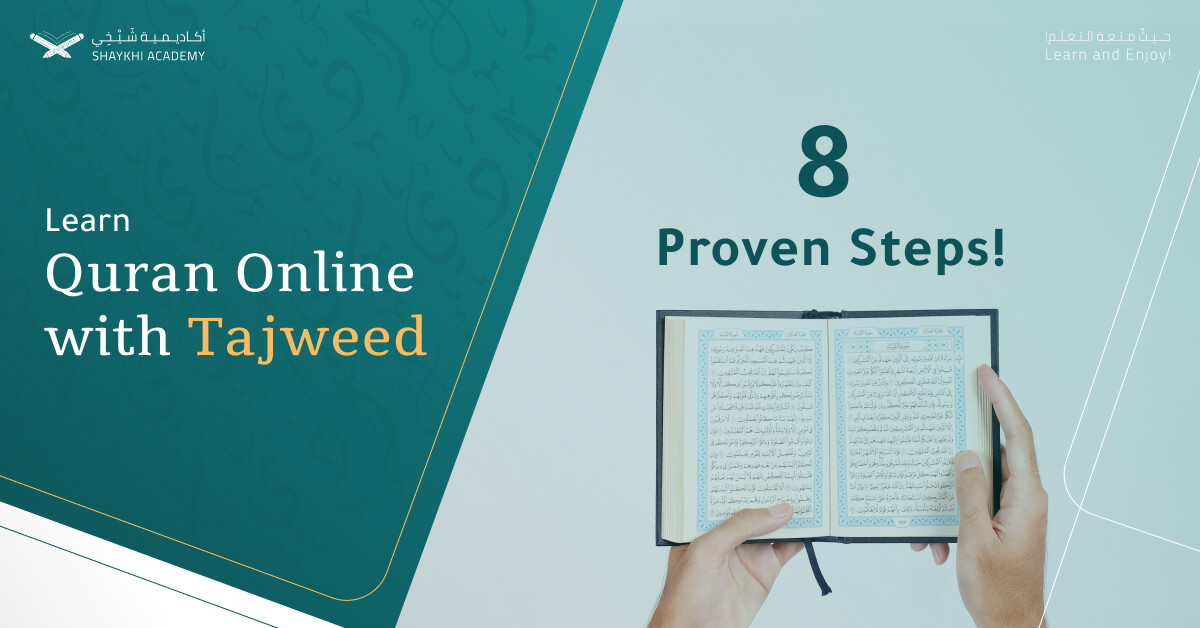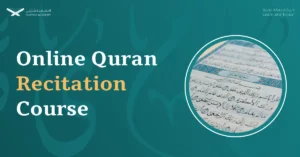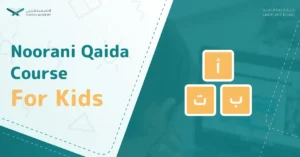Have you ever listened to a Quran reciter and been absolutely mesmerized by the beauty of their recitation? This is because they were using Tajweed, the rules and art of Quranic pronunciation.
If you’re a beginner eager to improve your own recitation or perhaps want to help your child or loved one connect with the Quran, you’re in the right place. In this article, we will explore what Tajweed is, offer tips on how to learn it, and discuss why it’s important for beginners. By the end, you will have a solid foundation to start your journey in reading the Quran with Tajweed.
In a nutshell, Tajweed is the set of rules for Quran recitation, improving pronunciation and connection with the Quran. Beginners can learn through a step-by-step approach, starting with the Arabic alphabet and basic rules. Tajweed is essential for preserving the Quran’s meaning and enhancing recitation.
What is Tajweed?
Tajweed (تجويد), derived from the Arabic root word ‘j-w-d’ meaning ‘to improve’ or ‘to make better’, refers to the set of rules governing the correct pronunciation of the letters and words in the Quran. It ensures that each sound is articulated clearly and that the recitation adheres to the phonetic principles laid down by Islamic scholars. Tajweed rules cover aspects such as:
- Makharij al-Huruf (Articulation Points of Letters): Ensuring each letter is pronounced from its correct point of origin.
- Sifat al-Huruf (Characteristics of Letters): Understanding the attributes of each letter, such as whether it should be pronounced heavily or lightly.
- Madd (Prolongation): The rules for extending the pronunciation of certain letters.
- Idgham (Assimilation): Guidelines for merging specific letters in recitation.
By following these rules, readers can ensure they are not only pronouncing the words correctly but also preserving the meanings intended in the Quranic text.
Why Should You Learn Tajweed?
Learning Tajweed might sound like a chore at first, but trust us, it’s like discovering a hidden treasure. It’s not just about pronouncing the letters correctly, it’s about connecting with the Quran on a deeper level. It’s like learning the secret language of your heart.
Imagine reading a letter from someone special. You wouldn’t just skim through it, right? You’d want to savor every word, every nuance. That’s what Tajweed does for the Quran. It helps you appreciate the beauty of each verse, the melody of each word. And when you truly understand what you’re reciting, it touches your soul in a way that’s hard to describe.
Plus, it’s a skill you can be proud of. You’ll be able to recite the Quran with confidence, knowing you’re doing justice to its words. And who knows, you might even inspire others to learn along with you. So, if you’re looking for a way to deepen your faith and connect with the Quran, give Tajweed a try. You won’t regret it!
How to Learn Quran Tajweed for Beginners
For a beginner, learning Quran Tajweed might seem complex at first, but breaking it down into manageable steps can make the process smoother. Here’s a guide to help you get started on mastering the art of Tajweed.
1. Understanding the Basics of Pronunciation
Begin by learning the correct pronunciation of Arabic letters. Arabic has unique sounds that might not exist in your native language, so it’s crucial to focus on the finer details:
- Master the Arabic Alphabet: Begin by thoroughly learning the Arabic alphabet. Pay close attention to the unique sounds of each letter, including the differences between short and long vowels, and the emphasis (tashdeed) and softening (tarqeeq) of certain letters.
- Articulation Points (Makharij): Each letter has a specific place in your mouth or throat from where it should be pronounced. Spend time practicing these sounds to ensure clarity. Mastering these points ensures clarity and correctness in recitation:
- Throat Letters (Halqi): Letters like ‘ع’ and ‘ح’ which come from the throat.
- Tongue Letters (Lisani): Such as ‘ت’, ‘د’, and ‘ذ’, which involve different parts of the tongue.
- Lip Letters (Shafawi): Including ‘ب’, ‘م’, and ‘و’, which use the lips.
- Characteristics of Letters (Sifaat): Letters have inherent qualities like strength, softness, or breathiness. Recognizing these qualities helps in pronouncing letters correctly.
2. Grasping the Principles of Tajweed
Get familiar with the basic principles of Tajweed, which will serve as the building blocks for your learning:
- Tajweed Terminology: Learn terms like Madd (prolongation), Qalqalah (echoing sound), and Ghunna (nasalization).
- Fundamental Rules: Understand the importance of precision in recitation, which ensures that the Quran is read as it was revealed.
- Tajweed Etiquette: Proper breathing, starting and stopping points in verses, and respectful recitation.
3. Explore the Core Rules of Tajweed
- Nun Sakinah and Tanween: Learn the rules for pronouncing the letter “noon” when it has no vowel (sukun) and the “tanween” (double vowel) sounds. These rules involve nasalization and blending sounds.
- Izhar, Idgham, Iqlab, Ikhfa: These are essential rules governing how certain letters interact with each other. They involve clarifying, merging, flipping, or concealing sounds depending on the context.
- Madd (Elongation): Understand the rules for elongating vowel sounds when certain letters appear. There are different types of madd with varying lengths.
4. Practical Application of Rules
Practice applying these rules with real Quranic text. For example, focus on:
- Noon Saakin and Meem Saakin: How they interact with other letters, and practicing with verses where these rules are frequently applied.
- Tanween: Noting how the ending of words changes pronunciation depending on the following letter.
5. Detailed Study of Madd (Prolongation)
Madd rules are vital in Tajweed, and they come in different types:
- Natural Madd (Madd Asli): Simple elongation of vowels.
- Secondary Madd: Occurs under specific conditions, like when a Hamzah (ء) or Sukoon ( ْ) follows.
- Study examples from the Quran to see how each type of Madd is applied.
6. Moving to Advanced Stages
Once you have a solid grasp of the basics, you can start exploring more advanced rules:
- Rules of Stopping and Starting (Waqf and Ibtida’): Understanding where to pause and where to resume recitation without altering the meaning.
- Hafs An Asim Recitation: Delve into the specific rules of the Hafs narration, which is widely used, and understand what distinguishes it from other Quranic narrations.
7. Use Resources
Utilize helpful tools like:
- Tajweed apps: These can provide interactive practice and feedback.
- Qualified teachers: Consider seeking guidance from a knowledgeable instructor.
- Online Courses: Platforms like Shaykhi Academy provides structured courses with video lessons and practice exercises such as Online Tajweed Course – Learn Tajweed Online.
Additional Tips for Beginners
- Start slow: Don’t rush through the learning process. Focus on accuracy and gradually increase your speed.
- Record yourself: Listening to your own recitation can help you identify areas for improvement.
- Join a study group: Learning with others can be motivating and provide valuable feedback.
Must Tajweed Be Applied When Reciting the Quran?
Yes, it is a must to learn and apply Tajweed rules that prevent incorrect pronunciation and preserve the meaning of the Quran. However, Tajweed rules that enhance the recitation but don’t change the meaning are recommended but not obligatory.
So, applying Tajweed when reciting the Quran depends on the type of Tajweed rules:
- Essential Tajweed Rules (Wajib): These rules must be followed as they prevent errors that could change the meaning of the Quran or distort the Arabic grammar. This includes correct pronunciation of letters and vowels.
- Beautifying Tajweed Rules (Mustahab): These rules are recommended, not obligatory. They relate to the finer details of pronunciation and recitation that enhance the beauty of the recitation without altering the meaning.
What are the Advantages of Quran Recitation with Tajweed?
Reciting with Tajweed isn’t just about following rules – it’s about connecting with the Quran on a deeper level. Here’s what you gain:
- Accurate Pronunciation: Tajweed ensures you’re pronouncing each Arabic letter and vowel sound correctly, preventing any changes to the intended meaning.
- Beautiful Recitation: Tajweed helps you recite the Quran in a melodious and captivating way, enhancing your spiritual experience.
- Spiritual Connection: As you focus on the rules of Tajweed, your concentration on the meaning of the verses deepens, fostering a stronger bond with Allah.
- Preventing Misinterpretation: Correct pronunciation ensures that the meanings of the words are conveyed accurately, preventing misunderstandings.
What is the Significance of Acquiring Tajweed Skills?
Learning Tajweed is an act of worship in itself. It shows your commitment to honoring the Quran and conveying its message as it was revealed. Imagine the Prophet Muhammad (peace be upon him) listening to your recitation – wouldn’t you want it to be as perfect as possible?
Tajweed isn’t just about rules; it’s about connecting with the divine words. When you master Tajweed, you:
- Honor the Quran: Your recitation becomes a tribute to the Quran’s sacredness and an act of devotion.
- Preservation of the Quran: By learning Tajweed, you contribute to preserving the Quran’s original form for generations to come.
- Enhanced Understanding: Correct pronunciation aids in understanding the meaning and nuances of the Quranic verses.
- Inspire Others: Your beautiful recitation can inspire others to learn and appreciate the Quran.
- Earn Rewards: The Prophet Muhammad (peace be upon him) emphasized the rewards for those who recite the Quran beautifully.
- Gain Confidence: Tajweed proficiency instills confidence in your recitation, both in private and public settings.
What Rewards Await Those Who Perfect Tajweed?
The rewards for mastering Tajweed are immense, both in this life and the Hereafter. They include:
- Divine Pleasure: Allah is pleased with those who strive to recite His words with perfection.
- Forgiveness of Sins: Your efforts to learn and apply Tajweed can be a means of seeking forgiveness for your sins.
- Elevation in Status: Reciters are promised an elevated status in Paradise.
Strategies for Quran Memorization Enhanced by Tajweed
Tajweed can be your secret weapon for memorization! The correct pronunciation and rhythm make the verses easier to remember. Here’s how:
- Distinct Sounds: Proper pronunciation helps you differentiate similar-sounding words, reducing the chances of mixing up verses.
- Rhythmic Flow: Tajweed’s rules create a natural rhythm that aids in memorization, making the verses easier to recall.
- Meaningful Engagement: When you understand the rules, you’re more likely to internalize the verses’ meanings, strengthening your memory.
How Long Does it Take to Learn The Quran With Tajweed for a beginner?
From 6 Months to 1 year or more. Actually, the time it takes to learn the Quran with Tajweed varies depending on the individual’s dedication, time commitment, and prior knowledge of Arabic. On average:
- Basic Proficiency: 3 months to 6 months of regular study.
- Intermediate Skills: 6 to 1 year with consistent practice and learning.
- Advanced Mastery: 1 year or more, depending on the level of expertise desired.
This depends on the individual, but it’s a journey worth taking. Some beginners might grasp it quickly, while others might need more time. Don’t rush! Start with the basics and gradually build your skills.
How to Learn Tajweed easily?
Alright, let’s get you started with learning Tajweed! It might seem daunting at first, but trust us, with the right approach, you’ll be reciting beautifully. Here’s what we suggest:
- Master the Arabic alphabet and its pronunciation.
- Find a qualified teacher. This is essential for learning proper Tajweed and receiving personalized feedback.
(Consider reaching out to us for a consultation with our experienced Quran teachers at Shaykhi Academy).
- Practice regularly. Set aside time each day to recite the Quran with Tajweed, starting with shorter passages.
- Listen to expert reciters. Pay attention to their pronunciation and try to emulate their style.
- Focus on one rule at a time. Start with simpler rules and gradually work your way up to the more complex ones.
- Don’t be afraid to make mistakes. Keep practicing, and you’ll eventually get the hang of it.
- Record yourself. This can help you identify mistakes and track your progress.
Inspired to Recite the Quran Beautifully? Let’s Perfect Your Tajweed!
You’ve just learned the basics of Tajweed, now let’s take your recitation to the next level. Shaykhi Academy’s Online Tajweed Course is designed specifically for beginners like you, who are eager to master the art of Quranic recitation.
Why Choose Shaykhi Academy’s Online Tajweed Course?
- Seamless Continuation: Build upon the foundational knowledge you gained from the “Tajweed for Beginners” article.
- Structured Learning: Follow a comprehensive curriculum that covers all essential Tajweed rules and techniques.
- Expert Guidance: Learn from experienced instructors who are passionate about teaching Tajweed.
- Interactive Experience: Engage with dynamic lessons and practice exercises tailored for beginners.
- Flexible & Convenient: Learn at your own pace, anytime, anywhere, fitting seamlessly into your busy schedule.
Start Your Tajweed Journey Today! Enroll Now in Shaykhi Academy’s Online Tajweed Course
Conclusion
In conclusion, mastering Tajweed is an enriching journey that offers numerous benefits for your Quran recitation and spiritual growth. While it requires dedication and consistent practice, the rewards are immeasurable. By following the step-by-step approach, utilizing interactive tools, and seeking guidance from qualified teachers, you can overcome the initial challenges and embark on a fulfilling path of learning.




















